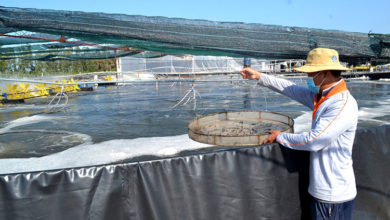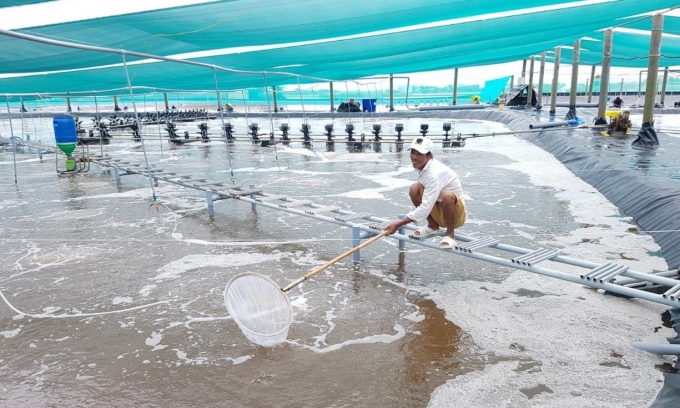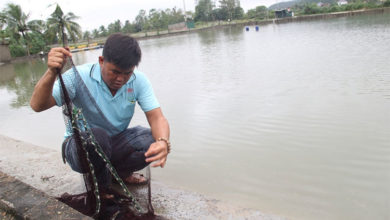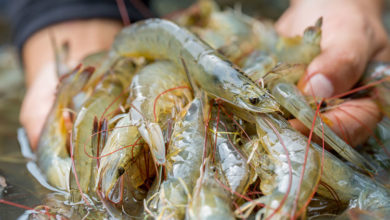Quang Tri: Efficiency of two-stage tiger shrimp farming in value chains
The Quang Tri Agricultural Extension Center initiated a project as part of the National Agricultural Extension Program aimed at transferring scientific knowledge and implementing innovative farming techniques. Titled “Establishing a Two-Phase Black Tiger Shrimp Farming Model Linked to the Value Chain,” the project has shown promising results after one year.
The project, running from 2024 to 2026, spans three provinces: Quang Binh, Quang Tri, and Thua Thien Hue. In 2024, the Quang Tri Agricultural Extension Center, as the lead agency, deployed 750,000 P15 black tiger shrimp juveniles across 3 hectares in brackish and saline aquaculture areas involving six households.
Farming process
In the first phase, shrimp juveniles are raised in small nursery ponds of 150–250 m² at high densities (800–1,200 shrimp/m²) under controlled conditions. Regular use of probiotics and biological products ensures a healthy environment, promoting shrimp growth and a high survival rate. After 25–30 days, when the shrimp reach a size of 1,500–1,700 shrimp/kg, they are transferred to grow-out ponds.
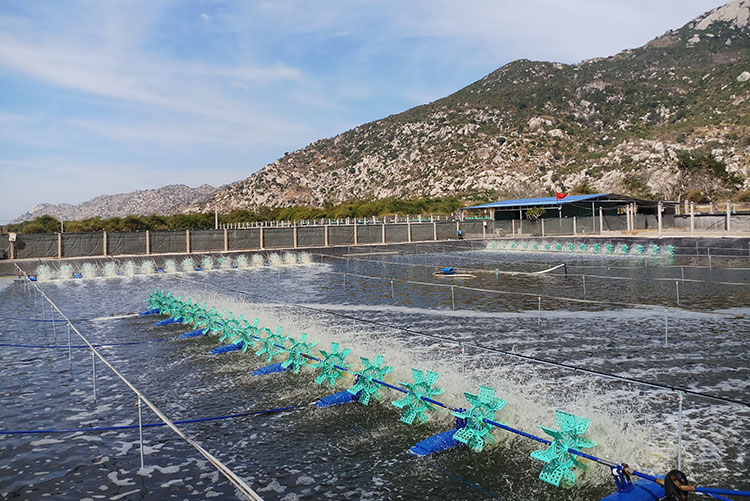
The second phase features a stocking density of 25 shrimp/m². Before the transfer, the water environment in both nursery and grow-out ponds is acclimatized to ensure consistency, supporting survival and robust development.
Training and outcomes
The project included three training sessions within the model and five additional sessions to expand its application, attracting nearly 240 participating households. These workshops enabled local farmers to adopt advanced techniques. After four months, shrimp grown under the model achieved sizes of 28–30 shrimp/kg, with survival rates exceeding 80% and an estimated yield of over 5 tons/ha, generating profits of more than 500 million VND/ha.
Farmer Van Phong Hai of Thua Thien Hue shared: “Previously, I raised white-leg shrimp, but disease outbreaks affected profitability. Thanks to support from the provincial Agricultural Extension Center, I transitioned to the two-phase black tiger shrimp model. The use of probiotics to stabilize water quality and prevent disease has led to remarkable results. I’ve expanded my operation to include three more ponds, and the shrimp are thriving.”
Local and long-term impact
Le Vy, Vice Chairman of Vinh Giang Commune, Quang Tri, noted: “This model has proven effective, reducing farming costs and yielding high production. With favorable shrimp prices, we plan to expand the two-phase farming area to over 10 hectares in the coming years.”
By shifting from extensive and traditional single-phase farming to the innovative two-phase model, costs during the initial farming month are reduced by 20–30%, while environmental management and disease prevention are improved. The model avoids the use of chemicals and antibiotics, ensuring food safety and higher economic value.
Chau Ngoc Phi, Director of the Agricultural Extension Center in Thua Thien Hue, emphasized the model’s benefits in diversifying species for farmers, particularly those operating shrimp ponds in sandy areas previously reliant on white-leg shrimp.
“This model provides an alternative for farmers and promotes sustainable aquaculture, ensuring long-term stability and profitability.”
A path to sustainability
The two-phase farming model offers improved survival rates, better growth control, and lower risks from environmental fluctuations. Phan Van Phuong, Deputy Director of the Quang Tri Agricultural Extension Center, highlighted the collaborative effort between farmers, scientists, managers, and businesses in ensuring the model’s success.
“We aim to continue this project to refine its efficiency and expand its application, helping farmers embrace innovative and sustainable farming practices.”
The model fosters knowledge-sharing among farmers, enabling the adoption of advanced technologies to enhance productivity, reduce environmental impacts, and boost economic returns. As shrimp farming faces challenges from diseases and fluctuating markets, the two-phase black tiger shrimp model presents a pathway to greater efficiency, higher incomes, and sustainable development.
VFM


